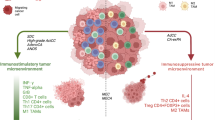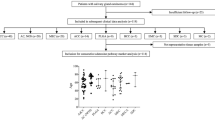Abstract
Salivary duct carcinoma (SDC) is an aggressive type of salivary gland carcinoma. Recently, immunotherapies targeting immune checkpoints, including PD1, PD-L1, CTLA4, and LAG3, have had a considerable prognostic impact on various malignant tumors. The implementation of such immune checkpoint inhibitor (ICI) therapies has also been attempted in cases of salivary gland carcinoma. The tumor immune microenvironment (TIME) is implicated in tumorigenesis and tumor progression and is closely associated with the response to ICI therapies. However, the TIME in SDC has not been fully explored. We examined the immunohistochemical expression of CD8, FOXP3, PD1, PD-L1, CTLA4, LAG3, and mismatch repair (MMR) proteins, tumor-infiltrating lymphocytes (TILs), and microsatellite instability (MSI) status in 175 cases of SDC. The associations between these TIME-related markers and the clinicopathological factors and prognosis were evaluated. An elevated expression of CD8, FOXP3, PD1, CTLA4, and LAG3 was associated with more aggressive histological features and an advanced N and/or M classification, elevated Ki-67 index, and poor prognosis. Furthermore, cases with a high PD-L1 expression exhibited more aggressive histological features and adverse clinical outcomes than those with a low expression. Alternatively, there was no significant correlation between TILs and clinicopathological factors. No SDC cases with an MSI-high status or MMR deficiency were found. The coexistence of both an immunostimulatory and immunosuppressive TIME in aggressive SDC might play a role in the presence of T-cell exhaustion. The contribution of multiple immune escape pathways, including regulatory T cells and immune checkpoints, may provide a rationale for ICI therapy, including combined PD1/CTLA4 blockade therapy.


Similar content being viewed by others
Data availability
The data that support the findings of this study are available from the corresponding author upon reasonable request.
References
Chiosea S, Agaimy A, Nagao T, et al. (2022) Salivary duct carcinoma. In: WHO Classification of Tumours Online, Head and Neck Tumours (WHO Classification of tumours series, 5th ed.; vol.9). https://tumourclassification.iarc.who.int/chapters/52. Accessed 19 June 2023.
Nakaguro M, Tada Y, Faquin WC et al (2020) Salivary duct carcinoma: Updates in histology, cytology, molecular biology, and treatment. Cancer Cytopathol 128:693–703. https://doi.org/10.1002/cncy.22288
Masubuchi T, Tada Y, Maruya S-i et al (2015) Clinicopathological significance of androgen receptor, HER2, Ki-67 and EGFR expressions in salivary duct carcinoma. Int J Clin Oncol 20:35–44. https://doi.org/10.1007/s10147-014-0674-6
Takase S, Kano S, Tada Y et al (2017) Biomarker immunoprofile in salivary duct carcinomas: clinicopathological and prognostic implications with evaluation of the revised classification. Oncotarget 8:59023–59035. https://doi.org/10.18632/oncotarget.19812
Fushimi C, Tada Y, Takahashi H et al (2018) A prospective phase II study of combined androgen blockade in patients with androgen receptor-positive metastatic or locally advanced unresectable salivary gland carcinoma. Ann Oncol 29:979–984. https://doi.org/10.1093/annonc/mdx771
Boon E, van Boxtel W, Buter J et al (2018) Androgen deprivation therapy for androgen receptor-positive advanced salivary duct carcinoma: A nationwide case series of 35 patients in The Netherlands. Head Neck 40:605–613. https://doi.org/10.1002/hed.25035
Takahashi H, Tada Y, Saotome T et al (2019) Phase II Trial of Trastuzumab and Docetaxel in Patients With Human Epidermal Growth Factor Receptor 2-Positive Salivary Duct Carcinoma. J Clin Oncol 37:125–134. https://doi.org/10.1200/jco.18.00545
Niwa K, Kawakita D, Nagao T et al (2020) Multicentre, retrospective study of the efficacy and safety of nivolumab for recurrent and metastatic salivary gland carcinoma. Sci Rep 10:16988. https://doi.org/10.1038/s41598-020-73965-6
Even C, Delord JP, Price KA et al (2022) Evaluation of pembrolizumab monotherapy in patients with previously treated advanced salivary gland carcinoma in the phase 2 KEYNOTE-158 study. Eur J Cancer 171:259–268. https://doi.org/10.1016/j.ejca.2022.05.007
Marabelle A, Fakih M, Lopez J et al (2020) Association of tumour mutational burden with outcomes in patients with advanced solid tumours treated with pembrolizumab: prospective biomarker analysis of the multicohort, open-label, phase 2 KEYNOTE-158 study. Lancet Oncol 21:1353–1365. https://doi.org/10.1016/s1470-2045(20)30445-9
Fayette J, Even C, Digue L et al (2019) NISCAHN: A phase II, multicenter nonrandomized trial aiming at evaluating nivolumab (N) in two cohorts of patients (pts) with recurrent/metastatic (R/M) salivary gland carcinoma of the head and neck (SGCHN), on behalf of the Unicancer Head & Neck Group. J Clin Oncol 37(15_suppl):6083. https://doi.org/10.1200/JCO.2019.37.15_suppl.6083
Tchekmedyian V, Sherman EJ, Dunn L et al (2019) A phase II trial cohort of nivolumab plus ipilimumab in patients (Pts) with recurrent/metastatic adenoid cystic carcinoma (R/M ACC). J Clin Oncol 37(15_suppl):6084. https://doi.org/10.1200/JCO.2019.37.15_suppl.6084
Burman B, Sherman EJ, Dunn L et al (2021) A phase II trial cohort of nivolumab plus ipilimumab in patients (Pts) with recurrent/metastatic salivary gland cancers (R/M SGCs). J Clin Oncol 39(15_suppl):6002. https://doi.org/10.1200/JCO.2021.39.15_suppl.6002
Cohen RB, Delord J-P, Doi T et al (2018) Pembrolizumab for the Treatment of Advanced Salivary Gland Carcinoma: Findings of the Phase 1b KEYNOTE-028 Study. Am J Clin Oncol 41:1083–1088. https://doi.org/10.1097/COC.0000000000000429
Rodriguez CP, Wu Q, Voutsinas J et al (2020) A phase II trial of pembrolizumab and vorinostat in recurrent metastatic head and neck squamous cell carcinomas and salivary gland cancer. Clin Cancer Res 26:837–845. https://doi.org/10.1158/1078-0432.CCR-19-2214
Sato F, Akiba J, Kawahara A et al (2018) The expression of programed death ligand-1 could be related with unfavorable prognosis in salivary duct carcinoma. J Oral Pathol Med 47:683–690. https://doi.org/10.1111/jop.12722
Hashimoto K, Yasumatsu R, Kuga R et al (2022) Treatment Efficacy of PD-1 Inhibitor Therapy in Patients With Recurrent and/or Metastatic Salivary Gland Carcinoma. Anticancer Res 42:981–989. https://doi.org/10.21873/anticanres.15558
Binnewies M, Roberts EW, Kersten K et al (2018) Understanding the tumor immune microenvironment (TIME) for effective therapy. Nat Med 24:541–550. https://doi.org/10.1038/s41591-018-0014-x
Veneroni MV, Festa BM, Costantino A et al (2023) Prognostic Impact of Tumor Immune Microenvironment and Its Predictive Role in Salivary Gland Cancer. Head Neck Pathol. https://doi.org/10.1007/s12105-023-01528-y
Fridman WH, Zitvogel L, Sautès-Fridman C et al (2017) The immune contexture in cancer prognosis and treatment. Nat Rev Clin Oncol 14:717–734. https://doi.org/10.1038/nrclinonc.2017.101
Pardoll DM (2012) The blockade of immune checkpoints in cancer immunotherapy. Nat Rev Cancer 12:252–264. https://doi.org/10.1038/nrc3239
Chang L, Chang M, Chang HM et al (2018) Microsatellite Instability: A Predictive Biomarker for Cancer Immunotherapy. Appl Immunohistochem Mol Morphol 26:e15–e21. https://doi.org/10.1097/pai.0000000000000575
Gerdabi S, Asadian F, Kiani R et al (2022) Simultaneous Expression of PD-1 and PD-L1 in Peripheral and Central Immune Cells and Tumor Cells in the Benign and Malignant Salivary Gland Tumors Microenvironment. Head Neck Pathol. https://doi.org/10.1007/s12105-022-01486-x
Schvartsman G, Bell D, Rubin ML et al (2021) The tumor immune contexture of salivary duct carcinoma. Head Neck 43:1213–1219. https://doi.org/10.1002/hed.26587
Hamza A, Roberts D, Su S et al (2019) PD-L1 expression by immunohistochemistry in salivary duct carcinoma. Ann Diagn Pathol 40:49–52. https://doi.org/10.1016/j.anndiagpath.2019.04.001
Nakano T, Takizawa K, Uezato A et al (2019) Prognostic value of programed death ligand-1 and ligand-2 co-expression in salivary gland carcinomas. Oral Oncol 90:30–37. https://doi.org/10.1016/j.oraloncology.2019.01.015
Linxweiler M, Kuo F, Katabi N et al (2020) The Immune Microenvironment and Neoantigen Landscape of Aggressive Salivary Gland Carcinomas Differ by Subtype. Clin Cancer Res 26:2859–2870. https://doi.org/10.1158/1078-0432.ccr-19-3758
Guazzo E, Cooper C, Wilkinson L et al (2021) Therapeutic implications of immune-profiling and EGFR expression in salivary gland carcinoma. Head Neck 43:768–777. https://doi.org/10.1002/hed.26529
Witte HM, Gebauer N, Lappöhn D et al (2020) Prognostic Impact of PD-L1 Expression in Malignant Salivary Gland Tumors as Assessed by Established Scoring Criteria: Tumor Proportion Score (TPS), Combined Positivity Score (CPS), and Immune Cell (IC) Infiltrate. Cancers (Basel) 12:873. https://doi.org/10.3390/cancers12040873
Geiger JL, Ismaila N, Beadle B et al (2021) Management of Salivary Gland Malignancy: ASCO Guideline. J Clin Oncol 39:1909–1941. https://doi.org/10.1200/jco.21.00449
(2021) NCCN Clinical Practice Guidelines in Oncology, Head and Neck Cancers https://www.nccn.org/professionals_gls/default.aspx. Accessed February, 14 2020
Brierley JD, Gospodarowicz MK, Wittekind C (2017) TNM Classfication of Malignant Tumours, 8th edn. Wiley-Blackwell, Hoboken, pp 47–49
Hendry S, Salgado R, Gevaert T et al (2017) Assessing Tumor-infiltrating Lymphocytes in Solid Tumors: A Practical Review for Pathologists and Proposal for a Standardized Method From the International Immunooncology Biomarkers Working Group: Part 1: Assessing the Host Immune Response, TILs in Invasive Breast Carcinoma and Ductal Carcinoma In Situ, Metastatic Tumor Deposits and Areas for Further Research. Adv Anat Pathol 24:235–251. https://doi.org/10.1097/pap.0000000000000162
Nakaguro M, Sato Y, Tada Y et al (2020) Prognostic Implication of Histopathologic Indicators in Salivary Duct Carcinoma: Proposal of a Novel Histologic Risk Stratification Model. Am J Surg Pathol 44:526–535. https://doi.org/10.1097/PAS.0000000000001413
Chow LQM, Haddad R, Gupta S et al (2016) Antitumor Activity of Pembrolizumab in Biomarker-Unselected Patients With Recurrent and/or Metastatic Head and Neck Squamous Cell Carcinoma: Results From the Phase Ib KEYNOTE-012 Expansion Cohort. J Clin Oncol 34:3838–3845. https://doi.org/10.1200/jco.2016.68.1478
Kesar N, Winkelmann R, Oppermann J et al (2020) Prognostic impact of CD8-positive tumour-infiltrating lymphocytes and PD-L1 expression in salivary gland cancer. Oral Oncol 111:104931. https://doi.org/10.1016/j.oraloncology.2020.104931
Liu S, Foulkes WD, Leung S et al (2014) Prognostic significance of FOXP3+ tumor-infiltrating lymphocytes in breast cancer depends on estrogen receptor and human epidermal growth factor receptor-2 expression status and concurrent cytotoxic T-cell infiltration. Breast Cancer Res 16:432. https://doi.org/10.1186/s13058-014-0432-8
Wu S, Liu X, Wang J et al (2020) DNA Mismatch Repair Deficiency Detection in Colorectal Cancer by a New Microsatellite Instability Analysis System. Interdiscip Sci 12:145–154. https://doi.org/10.1007/s12539-020-00358-8
Vital D, Ikenberg K, Moch H et al (2019) The expression of PD-L1 in salivary gland carcinomas. Sci Rep 9:12724–12724. https://doi.org/10.1038/s41598-019-49215-9
Chang H, Kim JS, Choi YJ et al (2017) Overexpression of PD-L2 is associated with shorter relapse-free survival in patients with malignant salivary gland tumors. OncoTargets Ther 10:2983–2992. https://doi.org/10.2147/ott.s134589
Wherry EJ (2011) T cell exhaustion. Nat Immunol 12:492–499. https://doi.org/10.1038/ni.2035
Arolt C, Meyer M, Ruesseler V et al (2020) Lymphocyte activation gene 3 (LAG3) protein expression on tumor-infiltrating lymphocytes in aggressive and TP53-mutated salivary gland carcinomas. Cancer Immunol Immunother 69:1363–1373. https://doi.org/10.1007/s00262-020-02551-6
Xu B, Jungbluth AA, Frosina D et al (2019) The immune microenvironment and expression of PD-L1, PD-1, PRAME and MHC I in salivary duct carcinoma. Histopathology 75:672–682. https://doi.org/10.1111/his.13944
Naito Y, Saito K, Shiiba K et al (1998) CD8+ T cells infiltrated within cancer cell nests as a prognostic factor in human colorectal cancer. Cancer Res 58:3491–3494
Kotoula V, Chatzopoulos K, Lakis S et al (2016) Tumors with high-density tumor infiltrating lymphocytes constitute a favorable entity in breast cancer: a pooled analysis of four prospective adjuvant trials. Oncotarget 7:5074–5087. https://doi.org/10.18632/oncotarget.6231
Chatzopoulos K, Collins AR, Sotiriou S et al (2020) Increased ERBB2 Gene Copy Numbers Reveal a Subset of Salivary Duct Carcinomas with High Densities of Tumor Infiltrating Lymphocytes and PD-L1 Expression. Head Neck Pathol 14:951–965. https://doi.org/10.1007/s12105-020-01163-x
Gargano SM, Senarathne W, Feldman R et al (2019) Novel therapeutic targets in salivary duct carcinoma uncovered by comprehensive molecular profiling. Cancer Med 8:7322–7329. https://doi.org/10.1002/cam4.2602
Acknowledgements
This work was supported by Tokyo Medical University Research Grant to N. Saigusa and JSPS Grant-in-Aid for Scientific Research (C) to Y. Tada (no.21K09616), T. Nagao (no. 20K07417, 23K06432), T. Matsuki (no. 20K07597) and M. Nakaguro (no. 22K06939) and a Grant-in-Aid for Young Scientists to H. Hirai (no. 19K165681, 22K06969) and C. Fushimi (no. 21K16835). The authors thank M. Yokotsuka for performing the gene mutation analysis and Y. Yamamoto and H. Yokota for performing the immunohistochemical analysis.
Author information
Authors and Affiliations
Contributions
All authors read and approved the final manuscript. The conception and design of the work, data acquisition, analysis, drafting the manuscript were performed by HH, MN, YT, NS, and TN. Material preparation and data collection were performed by all the authors. HH, MN, YT, NS, DK and TN preformed statistical analysis. YT, DK, YH and TN critically revised the manuscript.
Corresponding author
Ethics declarations
Ethical approval
The study was performed with ethical permission from the Institutional Ethics Review Board of each participating institution.
Consent to participate
Not applicable.
Conflict of interest
The authors declare no competing interest.
Additional information
Publisher's note
Springer Nature remains neutral with regard to jurisdictional claims in published maps and institutional affiliations.
Supplementary information
Below is the link to the electronic supplementary material.
Rights and permissions
Springer Nature or its licensor (e.g. a society or other partner) holds exclusive rights to this article under a publishing agreement with the author(s) or other rightsholder(s); author self-archiving of the accepted manuscript version of this article is solely governed by the terms of such publishing agreement and applicable law.
About this article
Cite this article
Hirai, H., Nakaguro, M., Tada, Y. et al. Prognostic value and clinicopathological roles of the tumor immune microenvironment in salivary duct carcinoma. Virchows Arch 483, 367–379 (2023). https://doi.org/10.1007/s00428-023-03598-3
Received:
Revised:
Accepted:
Published:
Issue Date:
DOI: https://doi.org/10.1007/s00428-023-03598-3




